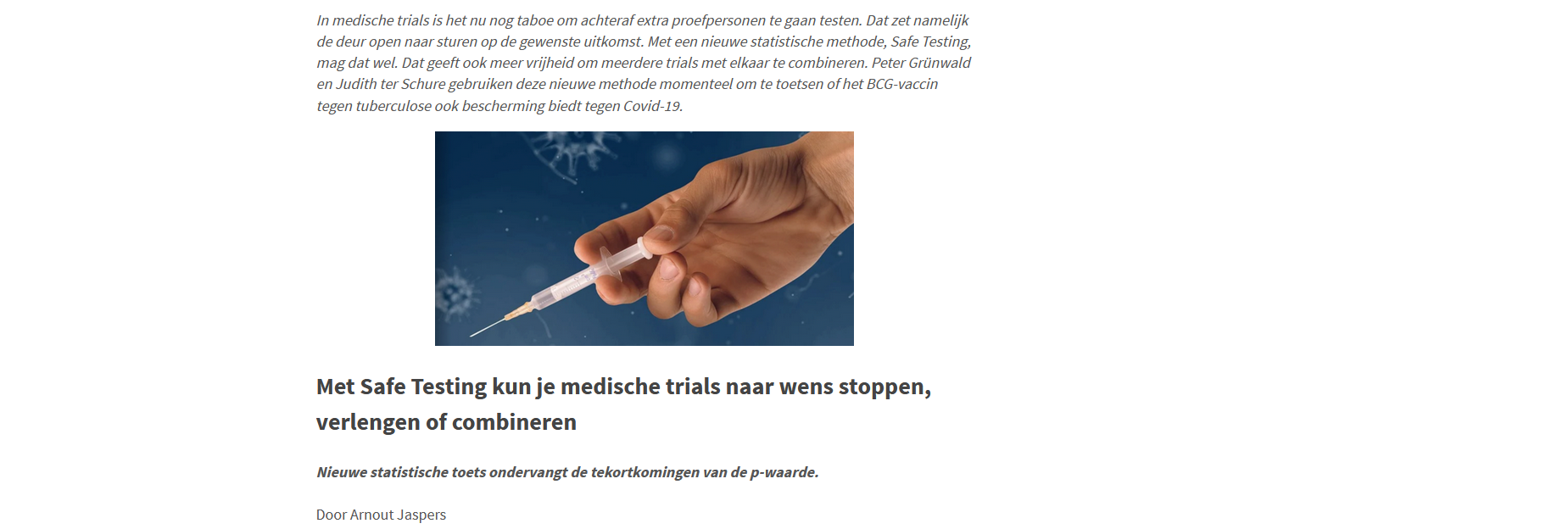- blog
- Scientists
- Peers
- General
- All
•
•
•
•
-
[All] Printed and dedicated Ph.D. dissertation
A very pretty collection of books. It is great to finally have the copies of your printed Ph.D. thesis in your hands! This is a link to the pdf of my dissertation: Judith ter Schure - ALL-IN meta-analysis.pdfI've dedicated the work to Glenn Shafer, Stephen Senn, Peter Grünwald, and Daniel Lakens. Three of them are obvious, given their guidance during my Ph.D. research. One is less obvious, as I've also dedicated my Ph.D. dissertation to Stephen Senn for professional guidance! Even though we've hardly ever met, his books and blogs were essential in my growing appreciation for clinical trial statistics. And it thought me another valuable lesson: our profession needs storytellers that can express its beauty, especially in The Netherlands, where hardly any new statisticians prepare for a career in clinical trials.Here I post the chapter that contains my Curriculum Vitae, so it has the necessary dates and distinctions, but also how I came to love statistics, writing, and clinical trials.
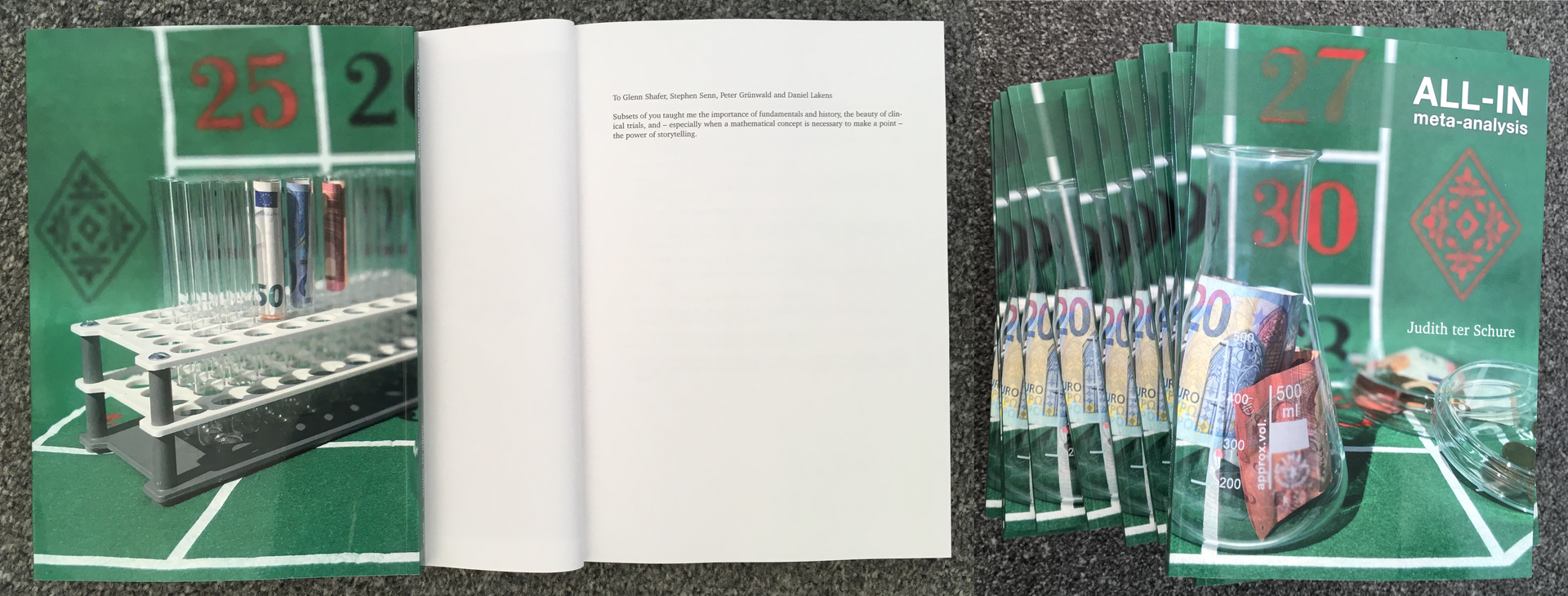
-
[All] ALL-IN meta-analysis: I submitted my Ph.D. dissertation!
Foto credits: Marjolein van Sommeren (conceptualization), Kilian Lafleur (digital edit), Rinske ter Schure (photographer), Thomas de Jong (photographer), Elsa ter Schure (photographer), Arnold ter Schure (encouragement)I submitted my Ph.D. dissertation to the committee! The title? ALL-IN meta-analysisIntroduction.pdfChapter 1 is based on a paper that is under review at F1000 and available on ArXiv:Judith ter Schure and Peter Grünwald. ALL-IN Meta-analysis: Breathing Life into Living Systematic Reviews. arXiv:2109.12141. 2021. Link.Chapter 2 is based on a paper that is available on ArXiv:Judith ter Schure, Muriel F. Pérez-Ortiz, Alexander Ly and Peter Grünwald. The Safe Logrank Test: Error Control under Continuous Monitoring with Unlimited Horizon.arXiv:2011.06931. 2020. Link.Chapter 3 is based on a paper that is published at F1000:Judith ter Schure and Peter Grünwald. Accumulation Bias in Meta-analysis: The Need to Consider Time in Error Control [version 1; peer review: 2 approved].F1000Research, 2019. Link.Chapter 4 is based on a blogpost at The Replication Network:Judith ter Schure. Accumulation Bias: How to Handle It ALL-IN. The Replication Network. 2020. Link.Chapter 5 is based on a blogpost at The Replication Network:Judith ter Schure and Peter Grünwald. Accumulation Bias: How to Handle It As a Bayesian. The Replication Network. 2022. Link (pdf).Chapter 6 is based on an article that is published in STAtOR, the society magazine of the Netherlands Society for Statistics and Operations Research VVSOR:Judith ter Schure, Peter Grünwald and Alexander Ly. Pandemic Preparedness in Data Sharing: Lessons Learned from Collaborating in a Live Meta-Analysis. STAtOR, 2021, 22.4: 47-52. Link.Discussion & Bibliography.pdf

-
[Peers] Testing by betting
A year ago, on September 9th 2020, we experienced a first moment for our new 'statistical paradigm'. Professor Glenn Shafer presented Testing by betting at the Royal Statistical Society (RSS) discussion session. A recording can be found here on YouTube. My colleagues at CWI and I were lucky that the Covid situation at the time allowed us to attend the virtual discussion session together while physically in the same room. You can see us for a short moment in the video at [1:19:41] with me in yellow.Since the beginning of my Ph.D., the group of researchers worldwide has grown that contributes to novel statistical techniques based on betting scores, e-values, and test martingales. The RSS discussion features, for example, dr. Aaditya Ramdas from Carnegie Mellon University [1:12:36 in the video], whose work was not familiar to us, not even to my supervisor, when I started my Ph.D. Just like Shafer and Vovk, Ramdas and his collaborators show the great mathematical results of the approach, and I like his angle in this RSS discussion: it creates new statistical possibilities that are impressive, also if you do not see the value of thinking about statistics in the language of betting. For me, however, that language of betting is the most important part because statistics needs to improve its track record of communication.Just as Professor Shafer, my supervisor Peter Grümwald and I believe that statistical communication will benefit from the notion of a betting score or e-value. In the acknowledgments of the accompanying paper, Shafer mentions that his discussion paper "was inspired by conversations about game-theoretic testing and meta- analysis with Peter Grünwald, Wouter Koolen, and Judith ter Schure at the Centrum Wiskunde & Informatica in Amsterdam in December 2018." It is very nice that he mentions that visit since for me, it really was a highlight of my Ph.D. We discussed why the p-value is so often misunderstood, and – with Shafer's wonderful historic knowledge – why it was introduced in the first place. His working papers on probabilityandfinance.com also go back to the early days of probability theory to show that thinking in terms of betting was very important for the groundwork of statistics.The empirical evidence that the p-value is misunderstood by doctors as well as writers of introductory textbooks served as a great introduction to Shafer's paper. Some of the discussants participating in the RSS discussion do not believe that betting scores will fare any better, but I am still optimistic. I do not want to accept yet that statistical inference is just too difficult.I have had good experiences piloting some meta-analysis-casino analogies in front of epidemiologists and qualitative researchers at the Research Integrity Amsterdam Lunch Meeting, which Shafer mentions in his reply [starting at 1:35:59]. It would be great to go beyond such anecdotal evidence. As I state in my written contribution [p. 360-361]:"I am already convinced that it will serve statistics well to replace p-values by bets, and power analyses by implied targets. But how do we know whether practitioners actually find this more intuitive? As an applied statistician, I will keep that question from the chat in mind as well, and see if I can design an experiment to test it." In his written reply [p. 473] Shafer adds:"Perhaps the most crucial choice will be the selection of participants. Will they be highly trained statisticians? Poker players, as Philip Dawid playfully suggests? Scientists, who use statistical tests? Students in statistics classes? Or perhaps teenagers? I did not play poker as a teenager, but I remember that my classmates, when disputing each others’ predictions, readily used betting taunts: ‘Wanna bet?’, ‘Put your money where your mouth is’. Imagine making these reports to teenagers: • Prof Shafer tested your app's rainfall predictions over the past year by betting against them and turned $1 into $10. He concluded that the app is not doing a good job. • Prof Shafer constructed a statistical model for your app's rainfall predictions over the past year. The app's predictions were inaccurate by an amount he would have expected only 1% of the time. He concluded that if his model is right, the app is not doing a good job. Which report would the teenager be more likely to remember? Which would she be able to repeat to a classmate? If you teach statistics, which do you think your students would be able to repeat accurately? "
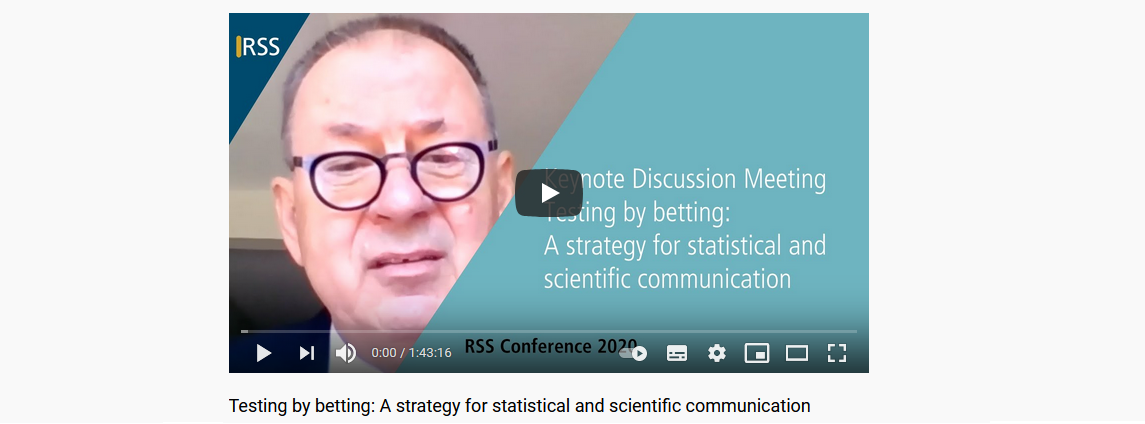
-
[General] Een paper en een blogpost over seks en survival analyse
Voor het VVSOR bloggerscollectief mocht ik weer een blogpost publiceren! Ditmaal over seks en een beetje survival analyse. Over het schatten van de leeftijd waarop jongeren hun eerste keer meemaken. Dit was een enorm interessant statistisch project dat ik heb gedaan voor het Rutgers Kennisinstituut Seksualiteit. Er was namelijk een rijke data set – het enquêteonderzoek Seks onder je 25e uit 2004, 2011 en 2016 – die vroeg om een uitgebreide statistische analyse.Over de resultaten en de uitdagingen van de analyse verscheen afgelopen zomer ons paper, dat ik schreef samen met Dr. Hanneke de Graaf van Rutgers en Dr. Geneviève van Liere van GGD Zuid-Limburg. Lees het hier op de website van de Journal of Public Health en hier in de repository van het CWI. De details, ruwe summary data, een statistisch stappenplan en lessons learned zijn hier beschikbaar op OSF.
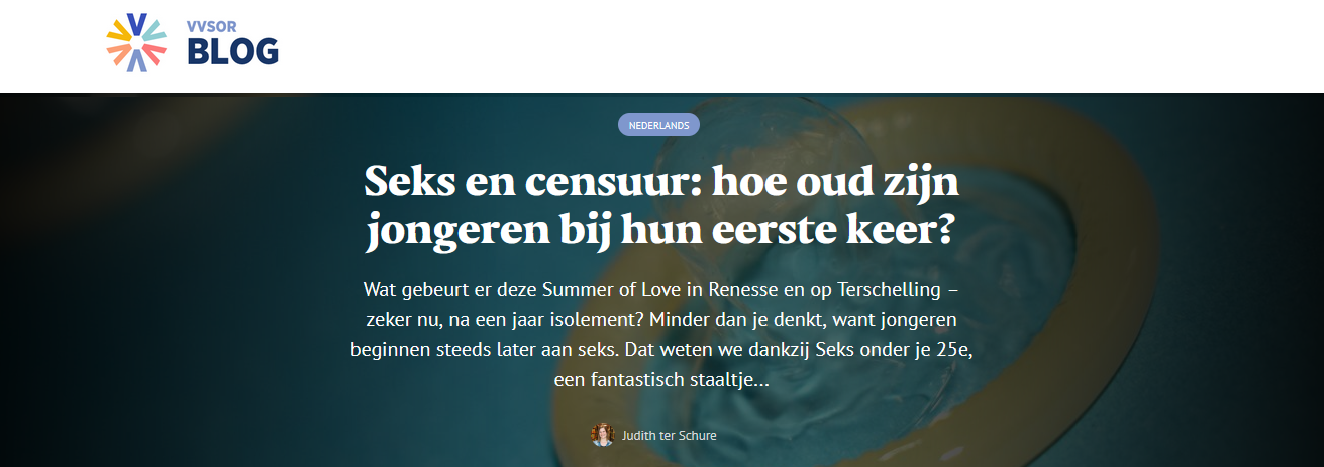
-
[General] VVSOR blog is live!
Vandaag mocht ik de VVSOR bloggers pagina aftrappen met een kort verhaal over coronarisico. Lees het hier!
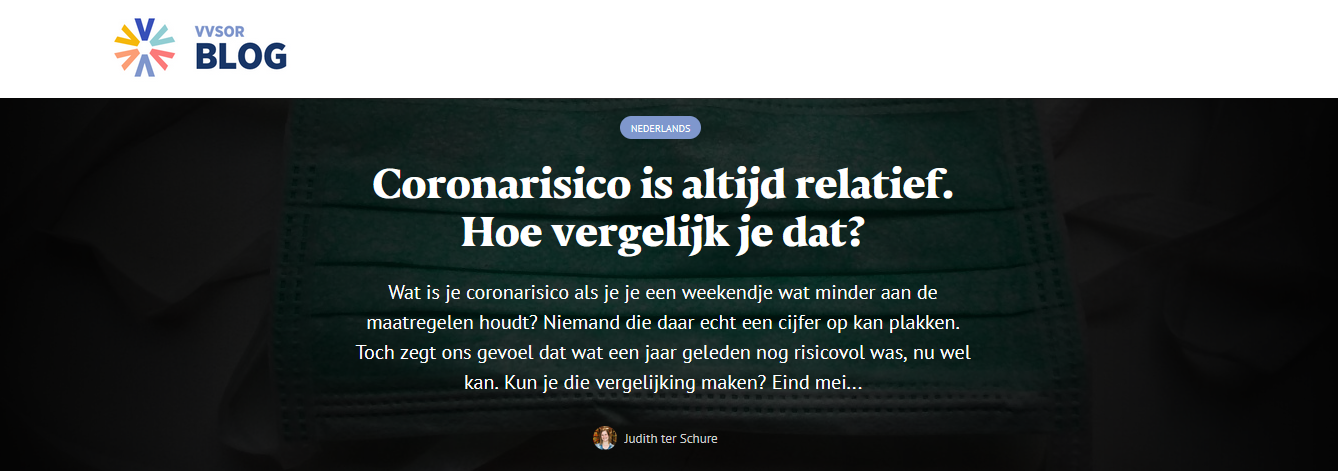
-
[General] Interview Academic Stories
It's my final year at CWI and I was asked to reflect on my experience there: on being a PhD student, a statistician and following the footsteps of Constance van Eeden, who was the first woman to graduate with a PhD from CWI in 1958. CWI will set up a PhD fellowship for female PhD candidates in her honour.You can read the interview here on the website Academic Stories.

-
[Peers/Scientists] Accumulation Bias: How to handle it ALL-IN
Yesterday, members of the VVSOR received the latest issue of our society magazine STAtOR with the seven-page article above. Credits for the nice format go to the STAtOR copy-editor Monique van Hootegem and the STAtOR editorial board that encouraged me to rewrite this piece. The original article appeared as a blogpost on The Replication Network thanks to the very kind invitation of Professor Bob Reed.The article argues for ALL-IN meta-analysis, Anytime Live and Leading INterim meta-analysis. It comes with a perspective on science that does not treat a series of studies as a fixed batch, but as a growing process that allows decisions to start or stop the research effort for which the meta-analysis itself could be Leading.The article first introduces the concept of Research Waste and the need to better inform new research by past results. Yet to achieve that ideal, we need to move away from conventional meta-analysis methods, since they suffer from Accumulation Bias if data-driven decisions are made on whether new research is necessary or wasteful. The selection of which studies to replicate affects the sampling distribution underlying conventional statistical methods. ALL-IN meta-analysis handles that problem by shifting the focus from a single sample distribution (that needs to condition on the sample and study series size), to a growing series.Here you can find the STAtOR article:STAtOR 2021 1, 21-27 JterSchure LR.pdfThe references and technical details can be found in a longer version of the article that is available in the CWI repository here.The R code that runs the simulations and produces the plots can be found here: Code Accumulation Bias How to handle it ALL-IN.R
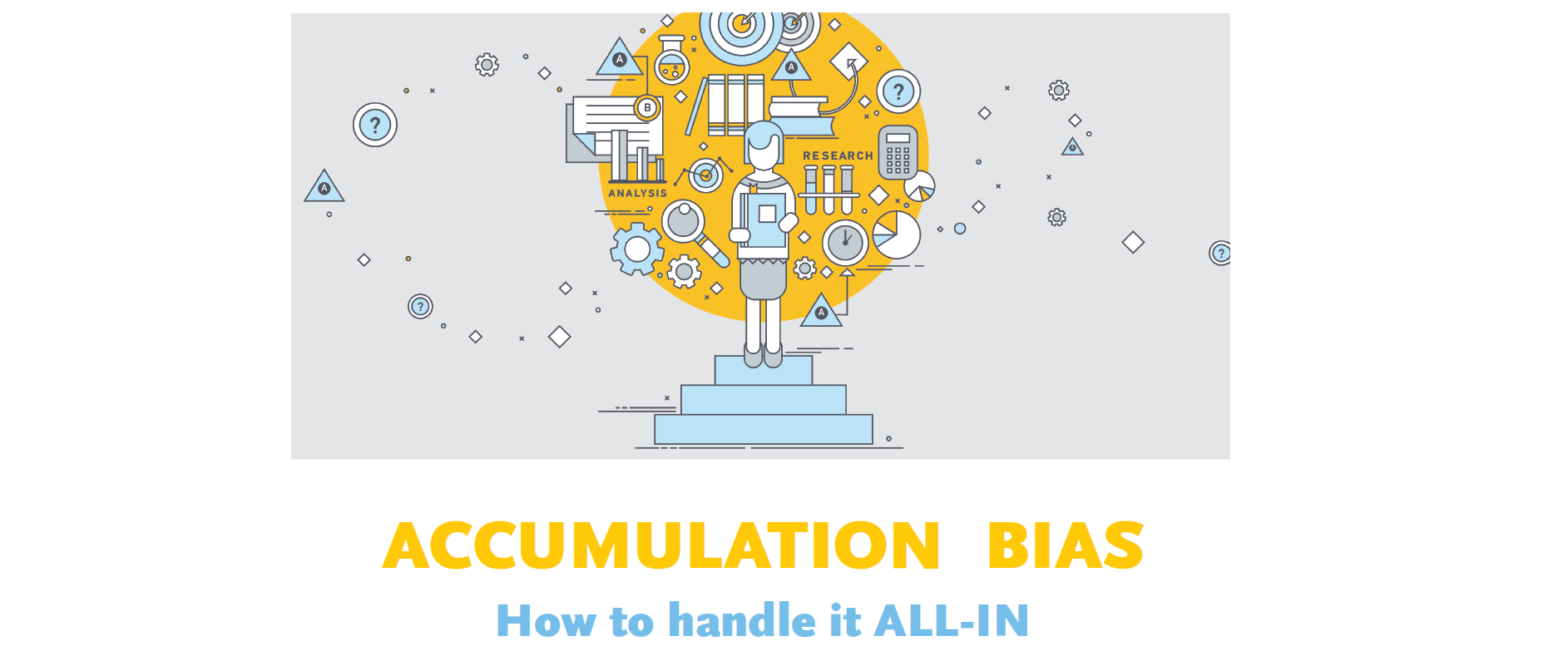
-
[General] Interview De Psycholoog
Kortgeleden kwam er een themanummer 'Big Data' uit van het tijdschrift De Psycholoog waarvoor journaliste Anouk Bercht een mooi interview heeft geschreven. Voor abonnees van De Psycholoog is het hier op hun website te lezen. Gelukkig mag ik voor niet-abonnees ook deze pdf delen: De Psycholoog interview.pdf
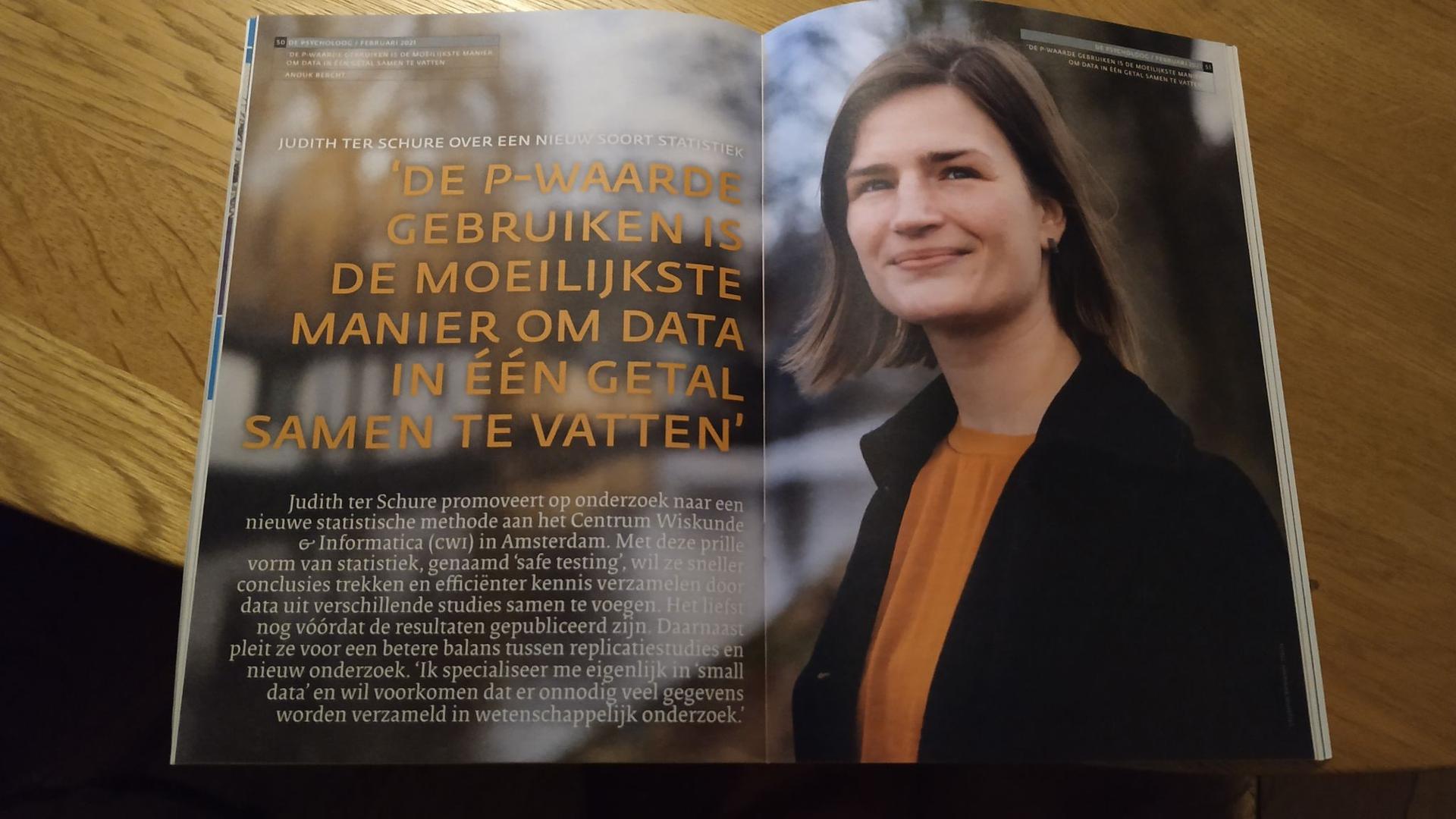
-
[General] Ski touring vs the daily commute: How risky is the backcountry?
1%. That is the amount of residual risk promised by snow and mountain safety guru Werner Munter. This is, of course, absurd.I first heard this percentage during a backcountry skiing course. Thankfully, I was not alone in my disbelief. A ‘one-in-a-hundred chance’ implies that we won’t survive more than a hundred skiing trips on average! Even if we planned every tour by the book – Munter’s book to be precise. Even if we base our decision on his ‘3 × 3 Filter- and Reduction' methodology that should make ski-touring risk acceptable.This article concerns the risk involved in unassisted backcountry ski touring. It argues that we do not really know how much or little safety is provided by risk-reduction techniques, such as the Werner Munter method. Fortunately, this does not mean that these risk management approaches are irrelevant; merely that there is significant work yet to be done.

-
[General] Artikel Arnout Jaspers over Safe Testing
Journalist en wiskundige Arnout Jaspers volgt het werk van mijn promotor Professor Peter Grünwald al enkele jaren en heeft er dit artikel over geschreven voor Platform Wiskunde Nederland. Heel tof!
